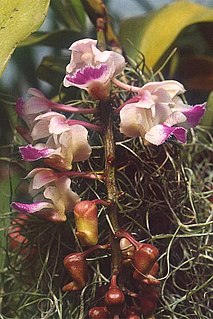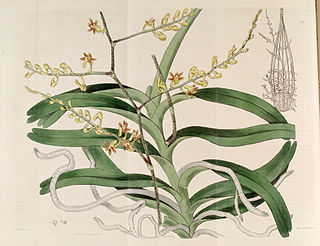
In the botanical classification of plants, Aeridinae is a subtribe of the tribe Vandeae whose representatives all have a monopodial growth habit and do not possess pseudobulbs.

Cornu aspersum, known by the common name garden snail, is a species of land snail in the family Helicidae, which includes some of the most familiar land snails. Of all terrestrial molluscs, this species may well be the most widely known. It was classified under the name Helix aspersa for over two centuries, but the prevailing classification now places it in the genus Cornu.
Brachylaima is a genus of trematodes. It has recently been discovered that it can infest the gastrointestinal tract of human beings.
Azure Bluet may refer to:

Helicidae is a large, diverse family of small to large, air-breathing land snails, sometimes called the "typical snails."

A land snail is any of the numerous species of snail that live on land, as opposed to the sea snails and freshwater snails. Land snail is the common name for terrestrial gastropod mollusks that have shells. However, it is not always easy to say which species are terrestrial, because some are more or less amphibious between land and fresh water, and others are relatively amphibious between land and salt water.

Herpetopoma is a genus of sea snails, marine gastropod molluscs of the family Chilodontaidae.

Cleisostoma is a genus of orchids with approximately 90 accepted species widely distributed through much of the Indian Subcontinent, Southeast Asia, China, New Guinea, and some of the islands of the Western Pacific.

A love dart is a sharp, calcareous or chitinous dart which some hermaphroditic land snails and slugs create. Love darts are both formed and stored internally in a dart sac. These darts are made in sexually mature animals only, and are used as part of the sequence of events during courtship, before actual mating takes place. Darts are quite large compared to the size of the animal: in the case of the semi-slug genus Parmarion, the length of a dart can be up to one fifth that of the semi-slug's foot.

Cleisostoma rostratum is a species of orchid found in Cambodia, Laos, Thailand, Vietnam and China.

Cleisostoma simondii is a flowering plant that grows upon larger trees, and known in Hong Kong as (Chinese:蜘蛛蘭). It also occurs in the Himalayas, Cambodia, Laos, Myanmar, Thailand, Vietnam, and other parts of China.

Snail slime is a kind of mucus, an external bodily secretion, which is produced by snails, which are gastropod mollusks. Land snails and slugs both produce mucus, as does every other kind of gastropod, from marine, freshwater, and terrestrial habitats. The reproductive system of gastropods also produces mucus internally from special glands.
C. paniculatum may refer to:

Herpetopoma aspersum, common name the speckled top shell, is a species of sea snail, a marine gastropod mollusk in the family Chilodontidae.

Plectorrhiza tridentata, commonly known as the common tangle orchid, is an epiphytic or lithophytic orchid that has many coarse, tangled roots, up to twenty egg-shaped leaves and up to fifteen green or brown, star-shaped flowers with a white labellum. It grows on rainforest trees and in other humid places and occurs between the Daintree National Park in Queensland and the far north-eastern corner of Victoria.
Cleisostoma williamsoni is a species of orchid. It is found in Asia.

Enallagma aspersum, the azure bluet, is a species of narrow-winged damselfly in the family Coenagrionidae. It is found in North America.

Cleisostoma crochetii is a species of orchid found in Vietnam, Cambodia and Laos.

Cleisostoma sagittatum is a species of orchid found in Borneo, Java, the Philippines and Sumatra. This species was first described by Blume in 1825.















